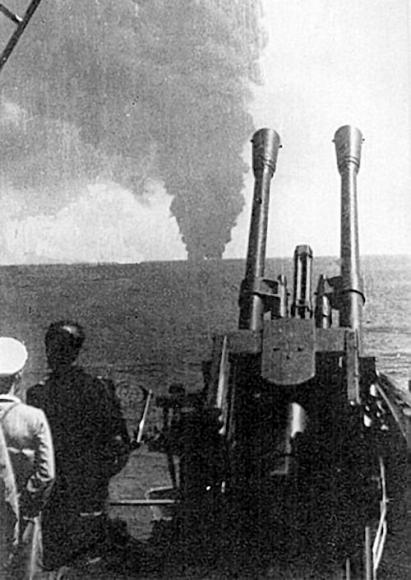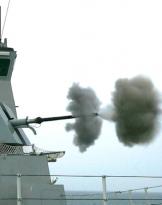(Continue) The five steamers, Troilus, Burdwan, Schedule (British), Tanimbar (Dutch) e singing (US), assigned to the operation and in convoy WS.19Z, sailed from the Firth of Clyde on 5 June, advancing into the Atlantic under the escort of the cruisers HMS Liverpool and HMS Kenya and ten destroyers; the tanker Kentucky however, she reached Gibraltar on her own account on 2 June where she underwent work to increase her embarked armament.
The units reassembled in Gibraltar on 11 June, where the merchantmen of the convoy, redesignated GM4, came under the responsibility of Captain Campbell Hardy, embarked on HMS Cairo and commander of close escort which also included four minesweepers; the two cruisers from Great Britain instead joined the Force H by Vice Admiral Curteis, who set about providing remote protection to the convoy.
The British units then forwarded into the Mediterranean, slowed down by the reduced speed (13 knots) that the merchant ships could develop; on 13 June the destroyers of the Force they refueled at sea from the Brown Ranger, with a certain delay due to the incorrect positioning of the tanker; the unit was then detached with her two escort corvettes to supply the British ships on their return voyage.
In fact, their movement had been noticed. On June 11 the Military Information Service intercepted a message from the US military attaché in Cairo, Colonel Bonner Fellers, which he decrypted having the code Black Code where news was given of two allied convoys to Malta.
The first news, which confirmed the movement of the convoy, reached the high command of the Italian navy (SUPERMARINA) on the morning of 12 June; although inaccurate, this information signaled the passage through the Strait of Gibraltar of about thirty British units bound for Malta.
SUPERMARINA then set about making the necessary arrangements: nine submarines were placed in two parallel lines between the Balearic Islands and the Algerian coast, with the task of signaling the passage of enemy units and launching a first attack; in the afternoon of 13 June, a formation of Italian torpedo bombers was made to take off from the airports of Sardinia, but returned to the base without having intercepted the enemy.
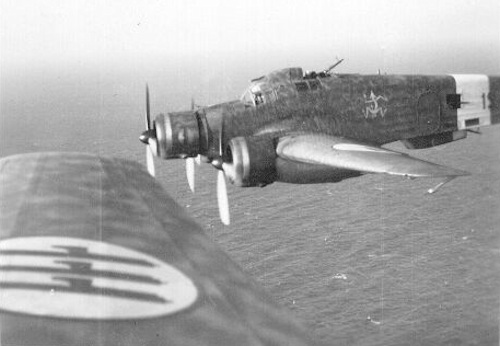
That evening two Italian scouts, sent to patrol the stretch of sea towards which the enemy units were presumed to be headed, finally managed to spot two British cruisers which had gone forward to patrol the approaches to the Strait of Sicily: at 16:30 on the 13 June, from Cagliari, the VII cruiser division of the admiral of division Alberto da Zara was set sail, with the light cruisers Eugene of Savoy (flagship) e Raimondo Montecuccoli escorted by seven destroyers of XIV and X squadrons (later reduced to five due to engine failures of two of them, the Vincenzo Gioberti and Nicolò Zeno, which returned to port), but the Italian units did not intercept the British ships, which had in the meantime withdrawn, and Da Zara returned to Palermo that same night.
In the early hours of June 14, the British units entered the range of the Italian submarines; stationed off Philippeville, the submarine Uarsciek sighted a British formation around 01:40, but the three torpedoes launched did not hit any targets. On her first operational mission, the submarine Giada sighted the units of Force H at 04:40 and the lieutenant Gaspare Cavallina brought the boat to the surface at just 2.500 meters from the British ships, launching a salvo of four torpedoes against the aircraft carrier Eagle; immediately submerged to escape the immediate counterattack of the opposing destroyers, Jade reported hearing two explosions but no British unit reported damage. The vessel was subjected to several depth charge attacks by destroyers, but suffered only minor damage.
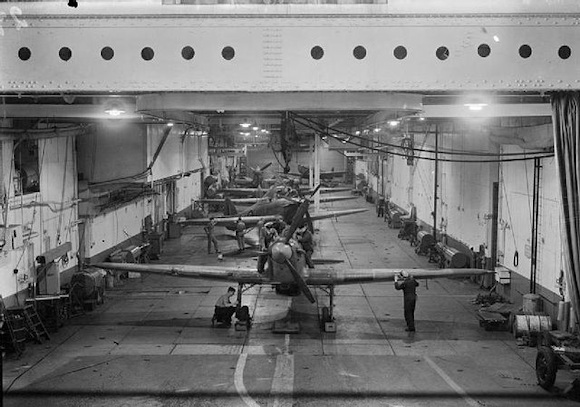 Starting at 09:00 on 14 June, the British formation also began to suffer air attacks from Axis aircraft based in Sardinia, initially eight Fiat CR42s with wing bombs accompanied by two Savoia-Marchetti SM79s from the 36th wing. These planes not only missed their targets but were also decimated by fighters Fulmar taken off from the aircraft carrier HMS Argus (photo).
Starting at 09:00 on 14 June, the British formation also began to suffer air attacks from Axis aircraft based in Sardinia, initially eight Fiat CR42s with wing bombs accompanied by two Savoia-Marchetti SM79s from the 36th wing. These planes not only missed their targets but were also decimated by fighters Fulmar taken off from the aircraft carrier HMS Argus (photo).
At 10:00 fifteen Savoia-Marchetti SM84 bombers arrived, also from the 36th wing, but the enemy reaction shot down six of them, including that of Colonel Giovanni Farina; only one, the one piloted by Lieutenant Oliviero Donati, managed to land without killing the crew. Soon after, at 10:15, other SM79 torpedo bombers, CANT Z.1007 bombers and Junkers Ju 88 arrived: the first wave counted 18 bombers, 32 torpedo bombers and a fighter escort, but in several subsequent waves and until the end of the day they were involved 250 Italian and 48 German aircraft.
The steamer Tanimbar, with a tonnage of 8.200 tons and a load of 13.000 tons, was hit with a torpedo by an SM.79 of the 130th group, immediately breaking in two and sinking due to the explosion of the aviation fuel and ammunition on board, while the cruiser HMS Liverpool it cashed a torpedo on the starboard side, probably launched by the pilot Arduino Buri's plane, taking on a large quantity of water which caused the rudder to block and a list of 7°; with speed reduced to 4 knots the cruiser was taken in tow by the destroyer HMS Antelope, and slowly tried to return to Gibraltar under the protection of a second destroyer, HMS Westcott.
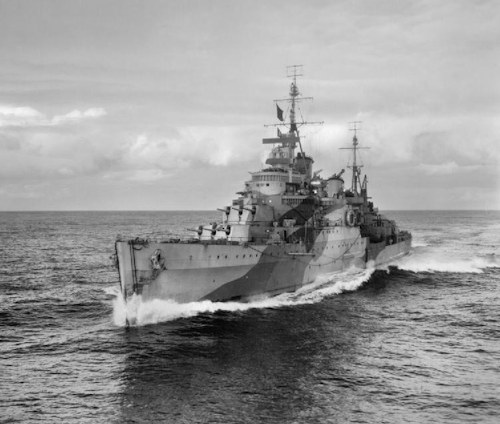 HMS Liverpool (photo) on 14 June she was hit in the engine room by an Italian torpedo bomber. The explosion seized the rudder and tappets in X and Y turrets, causing speed to be reduced to four knots and the ship began to list sideways due to the breach in the hull. Towed by destroyer Antelope towards Gibraltar, she was subjected to further air attacks, being further damaged by bombs dropped near the hull. On 17 June she finally arrived in Gibraltar.
HMS Liverpool (photo) on 14 June she was hit in the engine room by an Italian torpedo bomber. The explosion seized the rudder and tappets in X and Y turrets, causing speed to be reduced to four knots and the ship began to list sideways due to the breach in the hull. Towed by destroyer Antelope towards Gibraltar, she was subjected to further air attacks, being further damaged by bombs dropped near the hull. On 17 June she finally arrived in Gibraltar.
At 18:00, 92 Regia Aeronautica and 48 Luftwaffe planes went into action. In particular, fourteen SM79s of the 132nd autonomous torpedo bomber group took off from Castelvetrano which, meeting in the sky with the escort of 17 Reggiane Re.2001s of the 2nd land fighter group (2nd flight group) under the command of Lieutenant Colonel Aldo Quarantotti, together with seven Macchi MC202 of the 54th wing with Major Pier Giuseppe Scarpetta shooting down a Hurricane, sighted the British fleet over the Tunisian island of La Galite at about 19:00.
While the Reggianes claimed eleven Sea Hurricane with the loss of only one aircraft (but not the pilot), the SM79s released their torpedoes, which however did not explode because, as it was later ascertained, they came from a consignment of sabotaged ordnance coming out of the Baia torpedo factory. In the juncture the S.M.79 of second lieutenant Giannino Negri was shot down.
In the afternoon of the 15th the tug Salvonia sailed from Gibraltar took over the cruiser Liverpool, which was also joined the following day by the destroyer HMS Panther and other escort units: the formation then safely arrived in Gibraltar at 17:30 on 17 June. The Italian submarine also tried to take part in the attacks against the convoy Alagi, but his attempts to get within range were thwarted by the surveillance of the escort units; only after sunset the submarine managed to get close enough to launch two torpedoes against an aircraft carrier, which however did not hit.
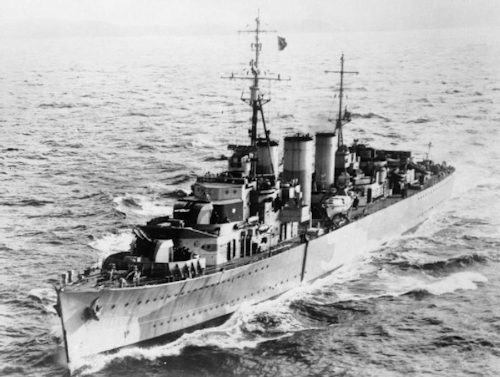 At sunset on June 14th, with the convoy now reaching the height of Bizerta and the mouth of the Sicilian Channel, the Force H reversed course and headed for Gibraltar: the British high command believed that the Italian navy would employ only light forces in the channel, easily counterable by Cairo and by the destroyers of the close escort, therefore without the need to further risk the main battle units.
At sunset on June 14th, with the convoy now reaching the height of Bizerta and the mouth of the Sicilian Channel, the Force H reversed course and headed for Gibraltar: the British high command believed that the Italian navy would employ only light forces in the channel, easily counterable by Cairo and by the destroyers of the close escort, therefore without the need to further risk the main battle units.
The minelayer Welsman, capable of a much higher speed than the merchantmen, separated from the convoy at 20:00 and proceeded alone to Malta: arrived in Valletta, delivered her cargo and left again at first light on 15 June, in order to provide anti-aircraft protection for the rest of the arriving convoy.
(Go on)
Read first part - The naval battle of Pantelleria, also known as the "battle of mid-June": premises
Read part three - The naval battle of Pantelleria, also known as the "battle of mid-June": Operation Vigorous
Photo: Regia Marina / Regia Aeronautica / IWM
(article originally published on https://www.ocean4future.org)

